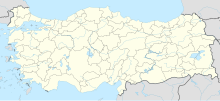Surp Nschan of Sebasteia
The Surp Nschan Monastery of Sebasteia ( Armenian Սուրբ Նշան վանք Սեբաստիո , Turkish Surp Nişan Manastırı ) is a former Armenian monastery complex near the city of Sivas (formerly Sebasteia) in what is now Turkey . It was founded in the 10th century and existed until it was destroyed in the course of the Armenian genocide in 1915.
Surp Nschan ( Armenian sacred sign ) is a saint name.
history
Surp Nshan Monastery was founded by Prince Atom-Ashot , son of King Senekerim in the 10th century. It was named after a relic that Senekerim brought from the Varagavank Monastery and that was returned there after his death. Up until 1915 it was one of the most famous centers of enlightenment and learning in Lesser Armenia - also during the rule of the Byzantines , the Seljuks and the Ottomans . During the genocide of the Armenians, the Surp Nschan monastery was the most important repository of medieval Armenian manuscripts in the Sebasteia region , at least 283 manuscripts were available there. The library was not destroyed during the First World War and most of the manuscripts have been preserved. In 1918 100 of them were given to the Armenian Patriarchate in Jerusalem .
Today the Surp Nshan Monastery has been destroyed and a military base occupies the area. The exact date of the destruction is not known.
Coordinates: 39 ° 34 ′ 19.9 " N , 36 ° 53 ′ 33.7" E
description
The monastery had three churches, their names were Surp Astvatsatsin (Սուրբ Աստվածածին, Holy Mother of God), Surp Khatch (Սուրբ Խաչ, Holy Cross), and Surp Hovhannes Karapet (Սուրբ Հովհաննես Կարապետ, Saint John the Harbinger). The monastery stood on a low hill overlooking Sivas and was surrounded by a plain and an outer wall. On one side of this wall was a large garden with fruit trees and vegetable patches . Several farms were also attached to the monastery.
Individual evidence
- ↑ Sivas Ermenileri: Bin Varmış, Bir Yokmuş
- ↑ a b c THE ARMENIANS OF SIVAS AND THEIR CHURCHES. Retrieved June 20, 2013 .

